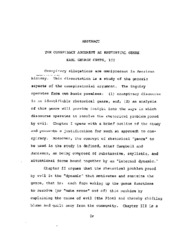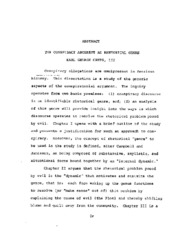| dc.contributor.author | Creps, Earl | en |
| dc.date.accessioned | 2021-01-14T21:18:47Z | |
| dc.date.available | 2021-01-14T21:18:47Z | |
| dc.date.issued | 1980-08 | en |
| dc.identifier.uri | archives.northwestu.edu/handle/nu/55304 | |
| dc.description | A dissertation submitted to the graduate school in partial fulfillment of the requirements for the degree, Doctor of Philosophy. | en |
| dc.description | Original item retained by donor. | en |
| dc.description.abstract | Conspiracy allegations are omnipresent in American history. This dissertation is a study of the generic aspects of the conspiratorial argument. The inquiry operates from two basic premises: (1) conspiracy discourse is an identifiable rhetorical genre, and; (2) an analysis of this genre will provide insight into the ways in which discourse operates to resolve the rhetorical problem posed by evil. Chapter I opens with a brief outline of the study and presents a justification for such an approach to conspiracy. Moreover, the concept of rhetorical "genre" to be used in the study is defined, after Campbell and Jamieson, as being composed of substantive, stylistic, and situational forms bound together by an "internal dynamic." | en |
| dc.description.abstract | Chapter II argues that the rhetorical problem posed by evil is the "dynamic" that motivates and sustains the genre, that is: each form making up the genus functions to resolve (or "make sense" out of) this problem by explaining the cause of evil (the Plot) and thereby shifting blame and guilt away from the community. Chapter III is a review of the primary and secondary literature on conspiracy. Secondary sources examined are from rhetorical, socio-political, and psychological research. This survey culminates in the formulation of tentative hypotheses designed to "map" the basic features of the genus. | en |
| dc.description.abstract | Chapter IV tests the hypotheses against a sample of discourse drawn from the Red Scare era (A. Mitchell Palmer's 1920 article, "The Case Against the 'Reds'"). Chapter V tests the hypotheses against an exemplar drawn from the conspiracy interpretations of the John F. Kennedy assassination (Mark Lane's 1966 bestseller. Rush to Judgment). The prepositional and strategic forms of the exemplars are reconstructed in detail and the information obtained is used to assess the validity of the definitional hypotheses. | en |
| dc.description.abstract | Chapter VI presents the study's conclusions. Although certain modifications were necessary, the generic "map" of conspiracy argument remained centered on three basic forms: a deductive/causal propositional substance, a dramatic/massively documented style, and a situation of perceived social stress. Finally, the study closes with suggestions for further research on the ethos of the conspiracy advocate and the question of sub-categories (e.g., extremist vs. mainstream) within the conspiracy genre. | en |
| dc.description.tableofcontents | Introduction: The generic study of conspiracy argument -- Rhetoric, community, and evil -- Mapping the conspiracy genre -- The conspiracy argument and the red scare -- The conspiracy argument and the John F. Kennedy assassination -- The conspiracy argument: Answers and further questions. | en |
| dc.format.extent | x, 320 pages | en |
| dc.format.medium | Paper | en |
| dc.language.iso | en | en |
| dc.publisher | Northwestern University | en |
| dc.rights | This original work is protected by copyright. Copyright is retained by the author(s). Works may be viewed, downloaded, or printed, but not reproduced or distributed without author(s) permission. | en |
| dc.rights.uri | http://archives.northwestu.edu/page/copyright | en |
| dc.title | The Conspiracy Argument as Rhetorical Genre | en |
| thesis.degree.name | Doctor of Philosophy | en |
| thesis.degree.level | Doctoral | en |
| thesis.degree.grantor | Northwestern University | en |
| thesis.degree.discipline | The Graduate School | en |



 Maintained by the Northwest University Library
Maintained by the Northwest University Library